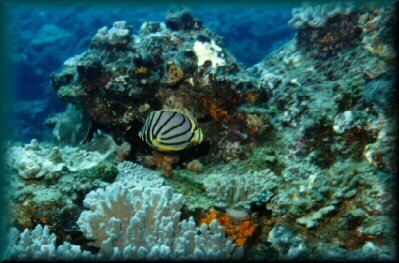 |
Chaetodon meyeri Common names SA - maypole
butterflyfish. |
 |
Chaetodon meyeri Common names SA - maypole
butterflyfish. |
| IDENTIFYING
FEATURES COLOUR, SHAPE AND SIZE |
The body is almost disc-shaped, and strikingly marked with nine or ten distinct black bands and stripes, which curve around the head and across the flanks and fins. The fins and outer margins of the body are yellow, while the sides are bluish. Young fish are predominantly bluish, especially when alive. Can attain 20 cm. |
| EXTERNAL ANATOMY | Some 41-47 series of small, ctenoid scales cover the entire body, making it rough to the touch. Though the fins are well developed, their close association with the body and its colours and patterns makes them less distinct. The single dorsal fin has 12 spines plus 23-24 rays and the anal fin has three spines plus 18-20 rays. The caudal fins truncate. Long, bristle-like teeth occur in each jaw of the small, slightly pouting, terminal mouth. |
| NATURAL HISTORY | This beautiful little fish is confined to coral reefs. In southern Africa, therefore, it occurs primarily in the St. Lucia Marine Reserve in Zululand. Here it is most likely to be encountered at depths ranging from 5-25 m as it darts about in pairs or small groups, constantly foraging for food. The maypole butterflyfish's almost total dependence on the coral reef environment is linked to its specialized diet, for it feeds virtually exclusively on soft coral polyps. Occasionally, however, it also preys on small crustaceans and worms. Though its breeding cycle is obscure, this species has been reported to cross with one or two other Chaetodontidae, especially in the Palan Islands of the Micronesian Pacific. |
| CAPTURE | Though it is a most desirable aquarium specimen, the maypole butterflyfish is difficult to capture and even more difficult to maintain in captivity. |
| This page hosted by |  |
Get your own Free Home Page |